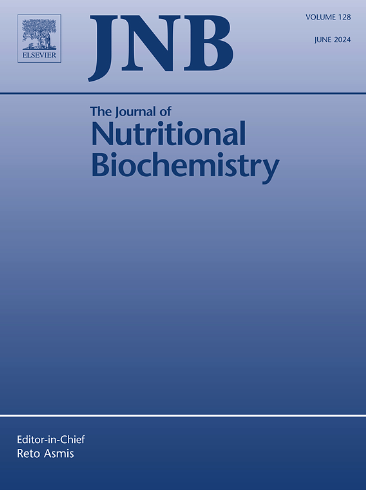天然分子 isoliquiritigenin 通过 PI3K/Akt 信号通路促进自噬,从而减轻小鼠的 MASH 和肝纤维化。
IF 4.8
2区 医学
Q1 BIOCHEMISTRY & MOLECULAR BIOLOGY
引用次数: 0
摘要
异桔梗甙元(ISL)是从甘草根中提取的一种黄酮类化合物,具有多种生物学和药理学特性。本研究旨在探讨 ISL 对代谢功能障碍相关性脂肪性肝炎(MASH)发病机制的保肝作用及其作用机制。C57BL/6小鼠以饲料或胆碱缺乏、L-氨基酸定义的高脂饲料(CDAHFD)为食谱,每天口服ISL(10 mg/kg)或载体。为了进一步探讨ISL在MASH发病机制中的作用,研究人员将AML12细胞暴露于棕榈酸(PA)作为脂质毒性的体外模型。结果表明,与用药物治疗的小鼠相比,ISL治疗减轻了MASH小鼠的肝损伤、脂肪变性、炎症和纤维化。此外,ISL还能减少MASH肝脏中CD68+巨噬细胞和活化的肝星状细胞(HSCs)的招募。体外实验表明,ISL可减少脂质积累,减轻PA诱导的AML12细胞的炎症反应。值得注意的是,RNA序列分析表明,ISL的抗MASH作用通过磷脂酰肌醇3-激酶(PI3K)/蛋白激酶B(AKT)/哺乳动物雷帕霉素靶标(mTOR)信号通路增强了自噬。通过评估 MASH 肝组织和 PA 刺激的 AML12 细胞体外自噬标记物,进一步验证了这一点。此外,分子对接分析表明,ISL的靶蛋白与PIK3同工酶具有很强的结合亲和力。总之,我们的研究结果突出表明,ISL通过PI3K/Akt/mTOR信号通路促进自噬,从而减轻小鼠的MASH和肝纤维化,为进一步研究人类MASH提供了可靠的证据。本文章由计算机程序翻译,如有差异,请以英文原文为准。
Natural molecule isoliquiritigenin mitigates MASH and liver fibrosis in mice by promoting autophagy through the PI3K/Akt signaling pathway
Isoliquiritigenin (ISL), a flavonoid derived from licorice root, has diverse biological and pharmacological properties. This study aimed to investigate the hepatoprotective effects and mechanism of action of ISL on the pathogenesis of metabolic dysfunction-associated steatohepatitis (MASH). C57BL/6 mice fed a chow diet or choline-deficient, L-amino acid-defined, high-fat diet (CDAHFD) received ISL (10 mg/kg) or vehicle daily via oral administration. To further explore the mechanism of ISL in MASH pathogenesis, AML12 cells were exposed to palmitic acid (PA) as an in vitro model of lipid toxicity. The results showed that, compared with vehicle-treated mice, ISL treatment alleviated liver injury, steatosis, inflammation, and fibrosis in MASH mice. Moreover, ISL treatment reduced the recruitment of CD68+ macrophages and activated hepatic stellate cells (HSCs) in MASH livers. In vitro experiments showed that ISL reduced lipid accumulation and mitigated inflammatory responses in PA-induced AML12 cells. Notably, RNA-sequencing analyses revealed that the anti-MASH effect of ISL enhanced autophagy via the phosphoinositide 3-kinase (PI3K)/protein kinase B (AKT)/mammalian target of rapamycin (mTOR) signaling pathway. This was further validated by assessing autophagy markers in both MASH liver tissues and PA-stimulated AML12 cells in vitro. Additionally, molecular docking analysis demonstrated that the target proteins of ISL exhibited strong binding affinity to PIK3 isoforms. In conclusion, our findings highlight that ISL mitigates MASH and fibrosis in mice by promoting autophagy through the PI3K/Akt/mTOR signaling pathway, providing reliable evidence to support further studies on MASH in humans.
求助全文
通过发布文献求助,成功后即可免费获取论文全文。
去求助
来源期刊

Journal of Nutritional Biochemistry
医学-生化与分子生物学
CiteScore
9.50
自引率
3.60%
发文量
237
审稿时长
68 days
期刊介绍:
Devoted to advancements in nutritional sciences, The Journal of Nutritional Biochemistry presents experimental nutrition research as it relates to: biochemistry, molecular biology, toxicology, or physiology.
Rigorous reviews by an international editorial board of distinguished scientists ensure publication of the most current and key research being conducted in nutrition at the cellular, animal and human level. In addition to its monthly features of critical reviews and research articles, The Journal of Nutritional Biochemistry also periodically publishes emerging issues, experimental methods, and other types of articles.
 求助内容:
求助内容: 应助结果提醒方式:
应助结果提醒方式:


